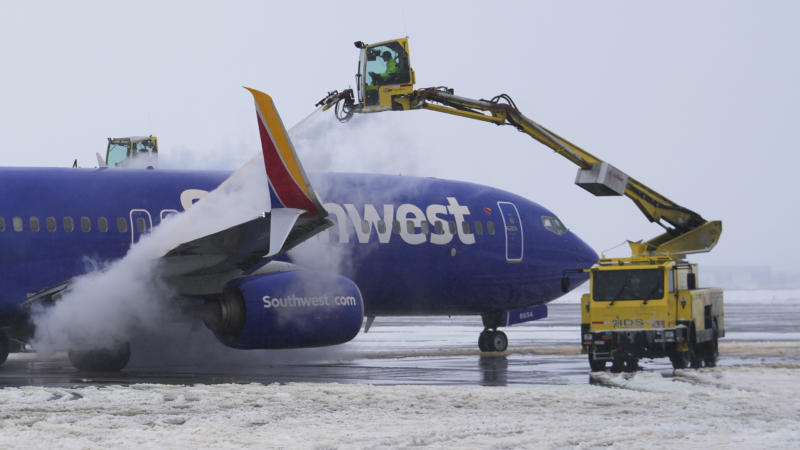As winter storms strike, airlines scramble to de-ice planes and keep them flying
WASHINGTON — When the temperature plunges, the de-icing crews go to work.
First the big truck pulls up alongside a plane. Then the bucket operator sprays the wings, tail and fuselage with a mixture of hot fluids that melts ice so the jet can take off safely.
“It’s just one of those frustrating times of year,” said Chris Manno, a retired airline pilot who spent 35 years at American Airlines. “Everything’s being done safely. There’s no good way to do it, other than slowly.”
This has been a challenging week for air travelers, as a major winter storm forced airlines to cancel thousands of flights and delay thousands more. Those problems were especially acute at airports around the nation’s capital, which saw more than half a foot of snow. A second storm is forecast to bring more precipitation to major airports in Dallas and Atlanta later this week.
The winter weather leaves airlines no choice but to de-ice planes before takeoff in order to keep them in the air, because even a small amount of ice on the wings can lead to serious problems.
“Not just heavy snow but actually very thin layers of frost can also have a very negative effect on lift,” said Kathleen Bangs, a former commercial airline pilot who is now a spokesperson for FlightAware, the flight-tracking website.

“Aircraft can be rolling down the runway,” Bangs explained. “And they will accelerate, and frequently get to liftoff speed. But when they try to take off, or they do get just a few feet off the ground, they’ll lose substantial lift, and the aircraft will no longer be able to fly.”
The de-icing process typically takes about 20 minutes for a smaller plane, Manno said. For larger jets, de-icing can add a delay of up to 40 minutes or more to each flight.
“It’s kind of a big logistics task,” he said. “Most airlines are doing a pretty good job of handling that. It’s just, it’s a slow process, and it has to be done right.”
If it’s not done right, the results can be catastrophic. In January 1982, an Air Florida jet crashed into the Potomac River moments after taking off from what was then called Washington National Airport, killing most of the passengers and crew on board. That accident – along with the crash of a USAir jet in New York City a decade later – led to more rigorous standards for de-icing.
Airlines now typically use two different types of chemical mixtures, depending on the situation: de-icing fluid and anti-icing fluid. De-icing fluid is heated to 140 degrees to remove frost, snow and ice from the wings and other critical surfaces, while anti-icing fluid prevents ice from forming. Polypropylene glycol is the key ingredient in both fluids.
While the technology behind de-icing has improved over the years, some things about the job have not changed.
“You’re in the elements. It’s snowing. You can barely see sometimes,” said Thomas Stevenson, a de-icer for Southwest Airlines based in Denver, in a video the company posted on YouTube. “It definitely gets cold. But I mean, that’s something you kind of signed up for when you took the job.”
His colleague, Jamie Martinez, says it’s an “awesome responsibility” to make sure a full plane carrying more than 140 passengers and crew members is ready for takeoff.
“We really try to consider every airplane as having a family member on that airplane,” Martinez said. “And that’s what we keep in mind to make sure that we’re doing the job correctly.”
It’s not just cold-weather climates where airlines have to worry about de-icing. It’s also a concern in warmer climates like Texas, Georgia and Florida.
“It is a necessity even this far down south,” said John Murphy, the assistant director of airside operations at Hartsfield-Jackson Atlanta International Airport. He says the airport has already seen more than a dozen days this winter when planes have required de-icing – even without any significant snowfall.
The airport is preparing for a major winter storm later this week that’s forecast to bring snow or freezing rain to a wide stretch of the South from Dallas to Atlanta. Murphy expects de-icing will once again be necessary.
“So you could see delays of upwards of an hour. That’s normal,” he said. “The name of the game is always safety.”
Those delays can be frustrating for travelers. But Kathleen Bangs with FlightAware says U.S. airlines and airports deserve credit for their performance during this week’s storm — even though thousands of flights were canceled or delayed.
“The truth is, they kept going. They kept operating. They did it safely,” she said. “You do the best you can. I mean, when you’ve got a foot of snow falling in some places, or ice covered runways, there’s you know, there’s a lot of places around the world that just shut down and don’t operate at all.”
The March Madness men’s bracket is out, and the SEC dominates with a record 14 teams
In an all-time record, 14 of the tournament's 68 teams all come from one conference — the SEC. The women's bracket will be unveiled at 8 p.m. Eastern time. Games tip off this coming week.
Pope Francis seen praying in first photo since his hospitalization a month ago
In the image published online by the Holy See Press Office, the pontiff was seated in a wheelchair and praying in the private chapel of Rome's Gemelli Hospital.
3 dead in Alabama after tornadoes pummel the South
The deaths came in Dallas and Talladega counties.
Hundreds of alleged gang members deported from U.S. despite court order
It was not immediately clear if the deportations happened before or after a federal judge in D.C. on Saturday issued an emergency order that told the administration to stop using wartime powers to deport anyone, and turn around any planes already in the air.
The missing children of Syria: Hidden in orphanages under Assad, where are they now?
Assad's forces detained mothers and children and sent many of the youth to orphanages. Syrians whose children vanished during the war are now seeking information on their fate. NPR investigates.
51 dead and more than 100 injured in nightclub fire in North Macedonia
A massive nightclub fire killed 51 people early Sunday in North Macedonia 's eastern town of Kocani, and injured more than 100. The blaze broke out during a concert by a local pop group.









